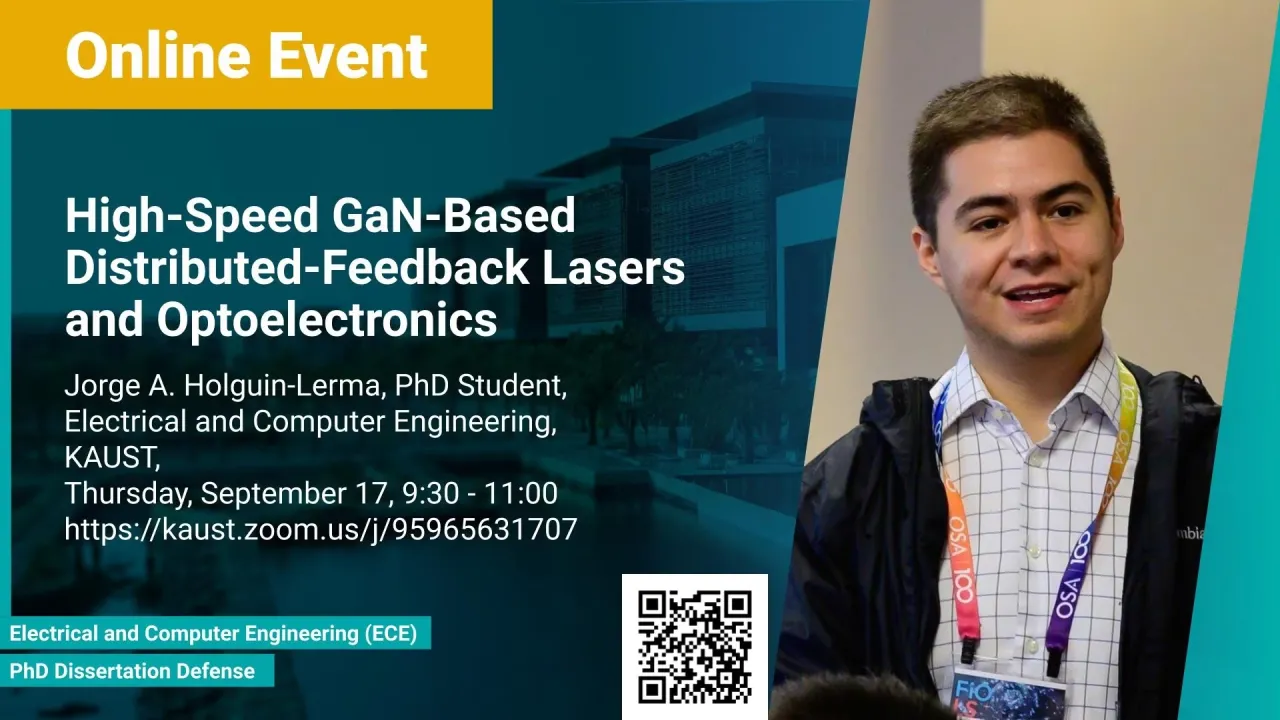
High-Speed GaN-Based Distributed-Feedback Lasers and Optoelectronics
Gallium nitride (GaN) is a semiconductor material highly regarded for visible light generation since it provides the most efficient platform for compact violet, blue, and green light emitters, and in turn, high-quality and ubiquitous white lighting. Despite this fact, the potential of the GaN platform has not been fully exploited. This potential must enable the precise control in the various properties of light, realizing functions beyond the conventional. Simultaneously, the field of the telecommunications is looking for candidate technologies fit for wireless transmission in the next generations of communication. Visible light communication (VLC) may play a significant role in the future of the last mile of the network by providing both a fast internet connection and a high-quality illumination.
Overview
Abstract
Gallium nitride (GaN) is a semiconductor material highly regarded for visible light generation since it provides the most efficient platform for compact violet, blue, and green light emitters, and in turn, high-quality and ubiquitous white lighting. Despite this fact, the potential of the GaN platform has not been fully exploited. This potential must enable the precise control in the various properties of light, realizing functions beyond the conventional. Simultaneously, the field of the telecommunications is looking for candidate technologies fit for wireless transmission in the next generations of communication. Visible light communication (VLC) may play a significant role in the future of the last mile of the network by providing both a fast internet connection and a high-quality illumination. Hence, a variety of optoelectronic platforms, including distributed-feedback (DFB) lasers, superluminescent diodes (SLDs), and multi-section lasers, can be used to exploit the full potential of GaN while offering unprecedented solutions for VLC and other applications, such as atomic clocks, high-resolution fluorescence microscopy, and on-chip non-linear processing at visible wavelengths. This dissertation demonstrates green and sky-blue DFB lasers based on GaN, with resolution-limited single-mode emission at wavelengths around 514 nm and 480 nm, side-mode suppression ratio as large as 42.4 dB, and application to up to 10.5 Gbit/s data transmission. Preliminary observations of DFB lasers with emission close to the Fraunhofer lines are presented, offering a pathway for low-background noise applications. Blue-emitting SLDs are used to demonstrate a 3.8 Gbit/s transmitter while achieving spectral efficiency of up 118.2 (mW・nm)/(kA/cm2) in continuous-wave operation. Visual quality is confirmed by coherence length and white light generation. Short-wavelength SLDs have the potential for higher resolution and fluorescence excitation in classical optical coherence tomography and fiber gyroscopes. The demonstration of a two-section green laser diode is presented, achieving coupled-cavity lasing at wavelengths of 514 nm based on an integrated green laser–absorber in self-colliding pulse configuration, operated in continuous wave electrical injection. The integrated laser offer potential for mode-locked and Q-switched lasing. The integrated laser is suitable for reconfiguration where laser–modulator, laser–absorber, and laser–amplifier are proposed and investigated at green wavelengths.
Brief Ph.D. Candidate’s Biography: Jorge A. Holguín-Lerma is a Ph.D. Student in Electrical and Computer Engineering (ECE) at the KAUST Photonics Lab. He holds an M.S. in Materials Science and Engineering (KAUST, Saudi Arabia, 2016), and a college degree in Electromedical Engineering (ULSA Chihuahua, Mexico, 2012). Before joining KAUST he worked as Component Engineer at Honeywell. Jorge has authored and co-authored 40+ journal papers and conference presentations. He has served as a technical referee for the journals Light: Science & Applications (Springer Nature), Applied Optics (OSA), Optics Letters (OSA), Optics Express (OSA), Photonics Journal (IEEE), Photonics Technology Letters (PTL), and Superlattices & Microstructures (Elsevier). He has served as the President of the KAUST OSA Student Chapter and he is a student member of SPIE, IEEE Photonics Society, and OSA. Jorge's recent outreach activities have directly impacted 350+ people in 6 countries with one-to-one engagement, public talks, and more.
Brief Biography
Jorge A. Holguín-Lerma is a Ph.D. Student in Electrical and Computer Engineering (ECE) at the KAUST Photonics Lab. He holds an M.S. in Materials Science and Engineering (KAUST, Saudi Arabia, 2016), and a college degree in Electromedical Engineering (ULSA Chihuahua, Mexico, 2012). Before joining KAUST he worked as Component Engineer at Honeywell. Jorge has authored and co-authored 40+ journal papers and conference presentations. He has served as a technical referee for the journals Light: Science & Applications (Springer Nature), Applied Optics (OSA), Optics Letters (OSA), Optics Express (OSA), Photonics Journal (IEEE), Photonics Technology Letters (PTL), and Superlattices & Microstructures (Elsevier). He has served as the President of the KAUST OSA Student Chapter and he is a student member of SPIE, IEEE Photonics Society, and OSA. Jorge's recent outreach activities have directly impacted 350+ people in 6 countries with one-to-one engagement, public talks, and more.
